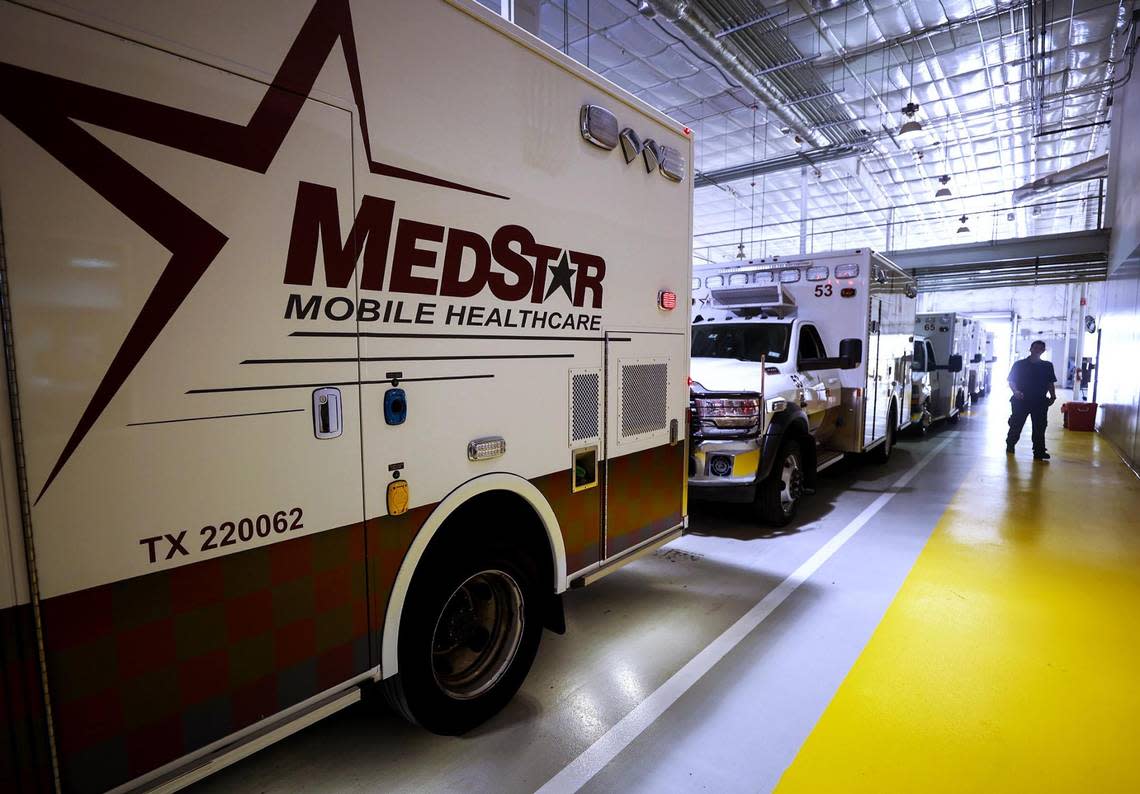MedStar call volume increases, resources stretched to meet demand for ambulances: report

MedStar’s call volume has increased more than 6% for the past two years, but fiscal constraints limit the number of resources the North Texas ambulance service can deploy to meet the growing demand, an interim report by an independent consultant shows.
MedStar’s Chief Executive Officer Ken Simpson told the Star-Telegram that operating expenses have gone up.
“EMT and paramedic wages have gone up significantly since the pandemic,” Simpson said. “The majority of our payers are governmental payers and Medicare and Medicaid, and they tend not to be as quick to increase their fee structures as the inflationary factors are.”
The report, presented to Fort Worth’s Ad Hoc Council Committee on Emergency Medical Response on Tuesday by Fitch and Associates, found that MedStar’s financial challenges are similar to what other EMS systems across the U.S. are facing.
Calls for EMS services have been increasing by 6.6% per year since 2021 over MedStar’s 14-city service area, but resources haven’t increased. The study showed that MedStar could improve response times by up to 5.5 minutes if its services “were optimally resourced.”
The current emergency response time, from the time the 911 call comes in, is less than 15 minutes 90% of the time, according to the report. Their desired response time objective is just under 11 minutes.
Today's top stories:
→ Rapist who attacked woman in West 7th area sentenced to 55 years
→ Report gives more details about wrong-way crash that killed 6
→ Baby clothing company faces backlash after firing new mom
🚨Get free alerts when news breaks.
“If we want to meet that 6% call increase and increase resources to match that, we can’t do it based on just patient services revenue and meet their goal of the community,” said MedStar spokesperson Matt Zavadsky.
MedStar is a governmental administrative agency which is owned by the member cities. One challenge it faces is the number of uninsured patients who can’t pay for their transport services. According to the Fitch report, nearly 19% of the population in Fort Worth does not have health insurance.
The ambulance provider services 14 cities in Tarrant County, including Fort Worth, Haltom City, White Settlement, Saginaw and Sansom Park, according to the agency’s website. MedStar hasn’t received funding from Fort Worth and the other member cities since 2010.
In September, the Fort Worth City Council approved $4.2 million in transitional funding to cover MedStar budget shortfalls while the Ad Hoc Council Committee on Emergency Medical Response reevaluates MedStar’s services and reviews other potential EMS models, such as service through the fire department.
MedStar later decided that the funding from the city wasn’t necessary. Simpson said MedStar will be contracting with John Peter Smith Hospital to pay for inmate transports from the county jail. The city of Fort Worth will reimburse MedStar for inmate transports from the city jail.
“Them taking responsibility for those patients and a couple other things we were able to do within the budget gave us the opportunity to balance the budget for this year while we work through this ad hoc process,” Simpson said.
Personnel resources are stretched as well. According to Zavadsky, current squads respond to seven or eight calls in a 12-hour shift, meaning that they are going out on calls 70% of the time they are on duty. The optimum scenario, according to the Fitch assessment, would see squads responding to six calls per 12-hour shift, or 50% of the time they are on duty.
“It’s not because we want them to — it’s just because the ability to afford additional resources is a challenge for us,” Simpson said.
As a way to maximize resources, Fitch recommended that MedStar increase the number of ambulances providing Basic Life Support services to about 50% of the ambulances deployed. According to Simpson, MedStar typically sends out between 14% to 17% of its ambulances with BLS services.
The majority of the ambulances deployed by MedStar provide Advanced Life Support, meaning they have paramedics on board who’ve received special training on administering cardiac medications and reading and interpreting EKGs, Simpson said.
The BLS ambulance are staffed by Emergency Medical Technicians. According to Simpson their training is similar to that of paramedics, but it doesn’t include the cardiac component.
Introducing more BLS ambulances into the system would be more cost effective, and according to Zavadsky, a very low percentage of calls require the ALS services.
The report also evaluated the reprioritization of calls that MedStar instituted in 2023.
“Our objective in reprioritization was to really narrow in on those time-sensitive, life-threatening calls and identify those and make sure we got the maximal response to those calls, because those are the ones that response times really make a difference with,” Simpson said. “And in doing that, it shifted some of the traditional call classification around a little bit.”
Fitch’s recommendation to MedStar was that the current system may be over complicated, suggesting it go back to the traditional prioritization model.
Fitch’s final report is scheduled to come out Feb. 20.
“We’re looking forward to the ongoing interim reports and the final recommendations because we think they’ll continue to support what we’ve been saying and explaining to our board and councils,” Simpson said.
